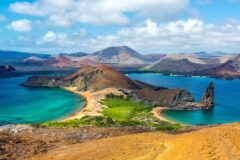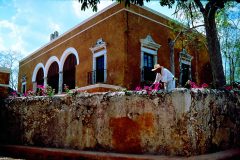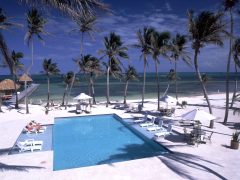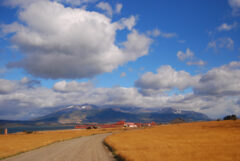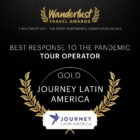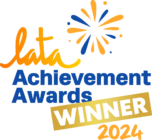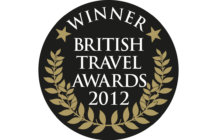Ultimate remoteness: The dream of Easter Island

Like many determined travellers, I’ve wanted to go to Easter Island all my life.
Ever since I first heard of this place, when I was a small boy dreaming over atlases, tracing faraway rivers with my finger, marveling at the gloriously exotic place-names – Azerbaijan, Okefenokee, Krasnoyarsk – there has been one place I prized above all others. And I know I am not alone.
Why does Easter Island exert this fascination? Two reasons, surely. First, it is swirled around with legends, centred on the famously enormous statues erected by the ancient inhabitants – statues known as moai (pronounced moe-aye). How and why these moai were erected, by a neolithic culture, is one of the world’s great mysteries.
The second reason Easter fascinates, and attracts, must be a result of its intoxicatingly faraway location. By some reckonings it is the most remote inhabited island on earth. If travelling is all about Getting Elsewhere then Easter Island is indeed the peak experience.
I hope.
And now I’m here, at last, touching down at the island’s only airport (the world’s most isolated airport, naturally) and I come armed with a brace of questions. Can this place live up to its billing? And why are there naked people in bodypaint dancing down the street?
A short taxi ride into the centre of Hanga Roa, Easter’s bucolic capital, indeed its only town – 80 per cent of the island’s 5,000 inhabitants live here – swiftly answers that final question. It appears we have arrived in the middle of Tapati, the annual carnival of traditional sports, like spear-chucking, ocean swimming, competitive dancing, poetry recitals, blowing through conches, sliding down cliffs on banana leaves (this is one of the major events) and, of course, walking around naked in bodypaint.
If you arrive in Easter during Tapati, you’ll find it’s a quick and intense introduction to local culture: and the first lesson everyone needs to learn is that Easter Island is not really Easter Island. Nor is it “Isla de Pascua”. No, Easter Island is Rapa Nui, according to the locals who go by the same name.
And the Rapa Nui, it seems, are utterly mad for horses. Feral horses can be found everywhere on Rapa, roaming the roads, grazing the pavements, or, bizarrely, standing sentinel in rows before the ahu – the lava-rock platforms which support the moai. Coming across these horses, ranked like a ghostly and riderless Household cavalry, besides the lofty sculptures, is a richly unsettling experience. Why do the Rapa Nui horses do this, uncommanded, often unseen? No one knows, of course. And who would want it any other way.
When the time comes to leave the languid and agreeable bustle of the town, and head for the bush – the 50 per cent of the isle that is a huge, open-air museum – my first port of call is Rano Kau. This is a deaf-mutingly enormous volcanic crater, filled with seething vegetation. It looks monstrous – like Satan’s Wok.
To add to the moodiness, right next door is a perilous clifftop village, Orongo. This place came into being when the 17th-century islanders, faced with an ecological catastrophe – fuelled by deforestation and overgrazing – decided to literally destroy the old civilization: topping the moai in a fit of iconoclastic fury. All the statues standing today were re-erected since the 50s.
It is a piquant story but perhaps I need to go deeper, have a more pro-active experience. So I shall try – by checking into a rampantly luxurious hotel, the Explora, famous for offering great treks and adventures, and for the fact that all the booze is free. Allied with its location in the Outback of the island, the Explora is thus the perfect place to go find the real, long-dreamed-of Rapa Nui.
So, map in hand, hat on head, sunblock on face, I scoot into the interior. Slowly the last of the trees thin out, and the bald volcanic slopes hove into view – shelving down to sunburned and desolate beaches, where moai stand, alone and together. In one astonishing location I see fifteen of them, near the sea and staring at the hills, lined up in a row like a terrible jury about to convict for murder. Nearby I find three more, still horribly toppled, slain forefathers suffering an eternal indignity – I can go right up and touch them. It’s a yearning, and tragic, and vastly compelling landscape. Now, at last, I am starting to get the vibe, the traveller’s rush. I’mreally here. Easter Island.
At Rano Raraku – the ancient island quarry – I discover half-finished moai actually jutting from the turf, like cowboys stuck in quicksand, struggling to get free. These are artworks abandoned, or aborted, by the crash of civilisations. As the writer Jared Diamond has said, it feels like the sculptors just dropped their tools one afternoon, expecting to be back after tea. Yet they never did. You half expect to find an unopen lunchbox, lying on the turf, next to a humble chisel.
The eeriness peaks on my final day, when out of nowhere I realize, with a chilling shiver, that I am 3000 kilometres from anywhere. It’s not like I didn’t know this before – it’s more that it’s only now hitting home. I can sense the daunting nullity around me. The silent wastes of water. The total desolation of the treeless isle. By the time I climb on my flight for Lima, at the little airport, my mind is a cocktail of confusion.
In a word: Wow. Looking back, I’m not sure what spooked me. Maybe some places are just too remote. Maybe it was all the free wine. Maybe it was island fever. A mystery. The one thing I do know, is that I can’t forget – even if I wanted to – this haunted and glorious place, the magnificent speck of strangeness that is Rapa Nui of the Moai. Three days after flying back in London, I have dreams about it. I’m still dreaming about it now. That has never happened to me before. Easter Island was everything I wanted – and something else, too.
Sean Thomas, writing for Sunday Times Travel Magazine.
Tailor-made holidays
Flexible, custom-made holidays to Latin America created to match your exact requirements: our tailor-made itineraries are as unique as the clients for whom they are designed.
Design my tripPapagaio
Your edit for Latin American inspiration
Our exciting range of articles on Latin America explore everything from iconic destinations and lesser-known cultural gems to delicious traditional recipes. You’ll also find exclusive travel tips, first-hand client reviews and the chance to get your personal questions answered by our travel experts.
View Extraordinary Inspiration